Walled sites, Sacrificial Pit and Large Building remains from Prehistory to Shang and Zhou Dynasties Found in Dongzhao, Henan Province
From:Chinese Archaeology NetWriter:Date:2015-04-10
From October in 2012 to December in 2014, School of Archaeology and Museology of Peking University in conjunction with the Institute of Archaeology and Cultural Relics of Zhengzhou City conducted the archaeological excavation and survey to Dongzhao Site. After three years’ work, archaeologists altogether excavated near 6000 square meters, explored about 700,000 square meters, achieved a series of great discoveries in Dongzhao Site, Henan province. Archaeologists found three surrounding walls, a large one, a middle one and a small one
The small walled area is located in the northeast of Dongzhao Site, rectangular, 150 meters’ long and 22,000 square meters. Only foundation trench of the wall is preserved and most of the moat is preserved. After dissection, it can be known that the wall foundation is about 4 meters’ wide, having tight rammed earth inside the trench, with clear rammed layers; and the moat is 5-6 meters’ wide and 3-5 meters’ deep. Pottery of the late Longshan culture was found from the foundation trench of east wall, and pottery shard of Xinzhai period were found in the foundation trenches and ditches of south wall and north wall. After preliminary estimate, the small walled remains started to be built in the period of Xinzhai Culture, and was abandoned in the first phase of Erlitou culture. It is the first city site of Xinzhai period found in Zhengzhou, which contributes greatly to knowing the cultural features, properties and belongings of Xinzhai period.
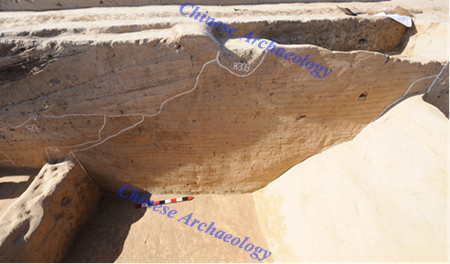
section of wall foundation of the small walled remain from Xinzhai culture at Dongzhao site, Henan province
The middle walled area is located in the middle of Dongzhao Site, trapezoidal, 350 meters’ long and 72,000 square meters. The south wall is 256 meters’ long; north wall is 150 meters’ long. Part of the wall was ruined, and only the foundation trench was left; and the width of the wall foundation is between 4 meters and 7 meters, and the trench had tight rammed earth and clear rammed layers. The ditch is 3 to 6 meters’ wide and 2 to 3 meters’ deep. The pottery shard found in the trenches of east, south and north walls and ditches were all from the second phase of Erlitou culture. After preliminary estimate, the middle city was built from the second phase of Erlitou culture, flourished in the late of the second phase of Erlitou culture and the beginning of the third phase of Erlitou culture, was abandoned in the fourth phase of Erlitou culture. Round crypt remains were concentratively distributed in the eastern area of the middle city from the second phase of the Erlitou culture, and sacrificial remains, such as complete pig skeletons, stone shovels, juvenile skeletons, turtle shells and etc, were found in some of the crypt remains. It is the first time to find such concentrative remains of this period, having significant meaning. In the north of the middle city, sacrificial remains were found, and it might be the main building area. In the south of the middle city, small house remains and a large number of living artifacts were found, and it might be residential area.

section of wall foundation of the middle walled remain from Erlitou culture at Dongzhao site, Henan province
The large walled area was severely damaged, rectangular, about 1000 meters’ long, 600 meters’ wide, and 600,000 square meters. The quality of rammed earth is high, and the pottery shard in the wall trench is from Eastern Zhou dynasty. The moat is 3 to 6 meters’ wide, 2 to 3 meters’ deep, and less objects were found within the ditch. The large building remain is from the Warring States period.
Sacrificial pit with oracle bones: H342, round, unearthing about 20 pieces of oracle bones, which were cattle scapula with obvious burning traces, is a sacrificial pit of the second phase of the Erlitou culture. It is the first site of Erlitou culture unearthing the most oracle bones, having significant meaning.
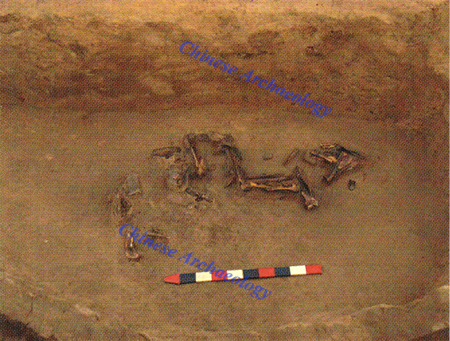
Sacrificial pit with oracle bones form Erlitou culture found at Dongzhao site, Henan province
The first sacrificial remains inside the wall foundation of Erlitou period: In the trench of the south wall of the middle city, a child skeleton was found, which is related to sacrifice rites, and it is the only phenomenon found in this site.
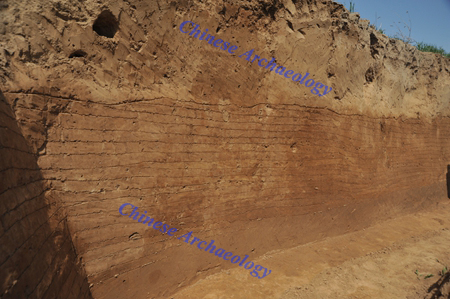
section of large building foundation of Shang dynasty at Dongzhao site, Henan proveince
Large building foundation of Shang dynasty found: The large building foundation of Shang dynasty is located in the southeast of the middle city. It is confirmed that the site is ambulatory-shaped, 75 meters’ long from the east to the west, 40 meters’ long from the south to the north, with an area of 3,000 square meters. The courtyard is in the middle, the main hall is in the north, and the corridor is in the south. From the unearthed relics, the age of the building might from the early period of the lower layer of Erligang culture to the late period of the lower layer of Erligang culture.
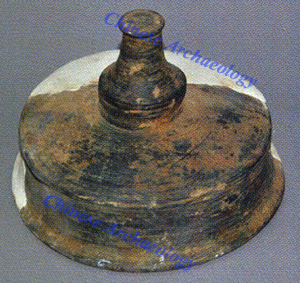
unearthed pottery from Xinzhai culture at Dongzhao site, Henan province
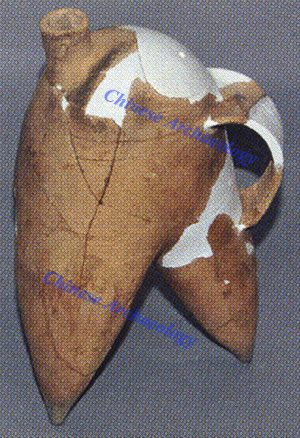
unearthed pottery from Erlitou culture at Dongzhao site, Henan province
So far, nearly 500 ash pits, 100 wells, as well as tombs, pottery kilns, pools and etc have been cleared up in Dongzhao site. Dongzhao site spans long period from Xinzhai culture, Erlitou culture, Erligang culture, and Western Zhou dynasty, with complete sequence. Among them, the cultural remains of Erlitou and Erligang periods are the most abundant. A large number of cultural relics were unearthed, mainly pottery and stones, few bone ware and clam ware, and shell money from the Shang and Zhou dynasties. (Translator: Wang Jue)

